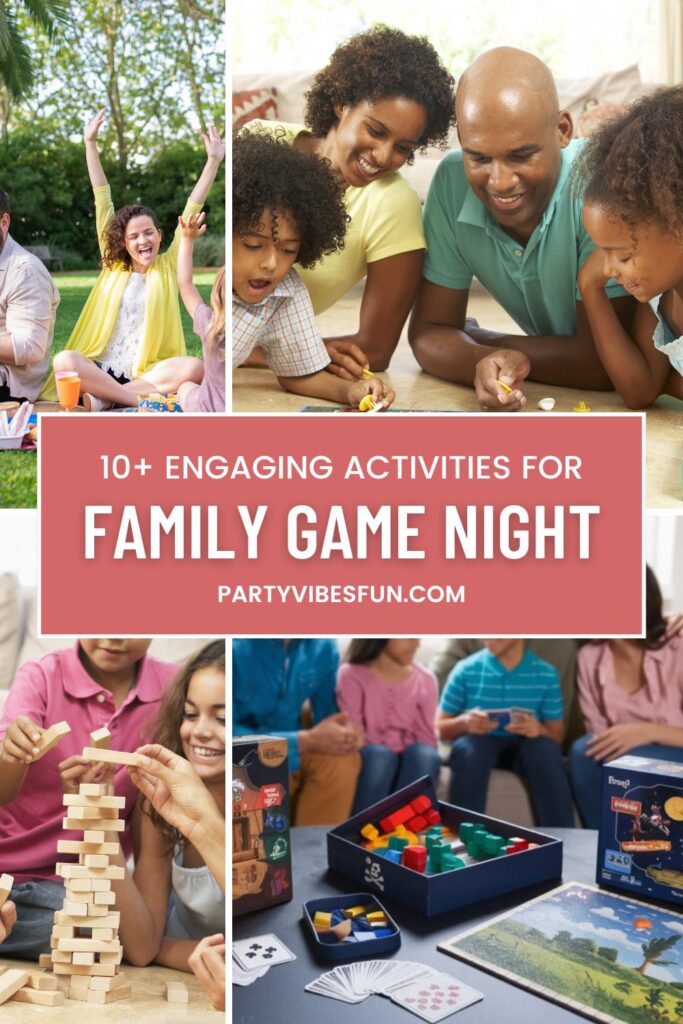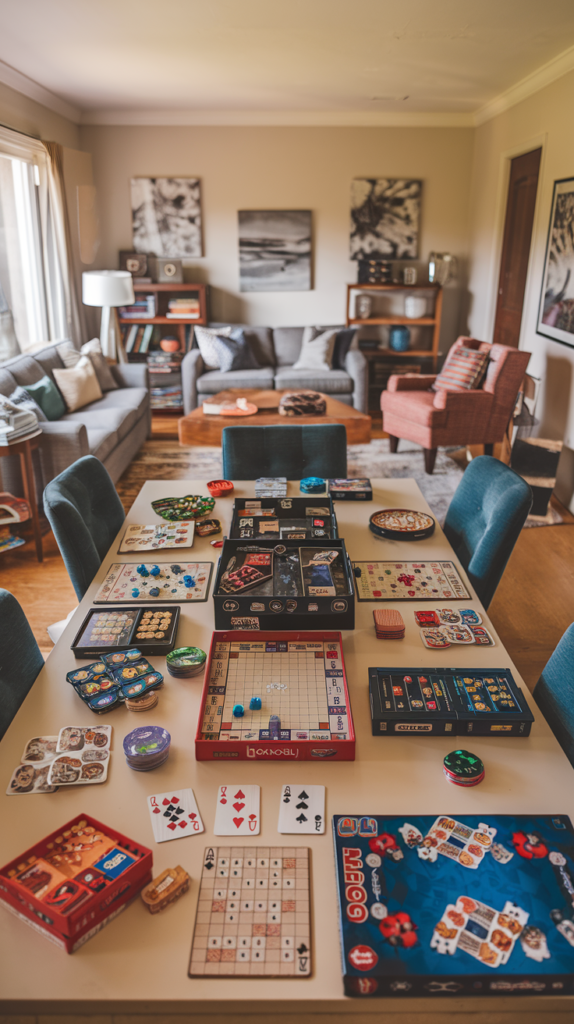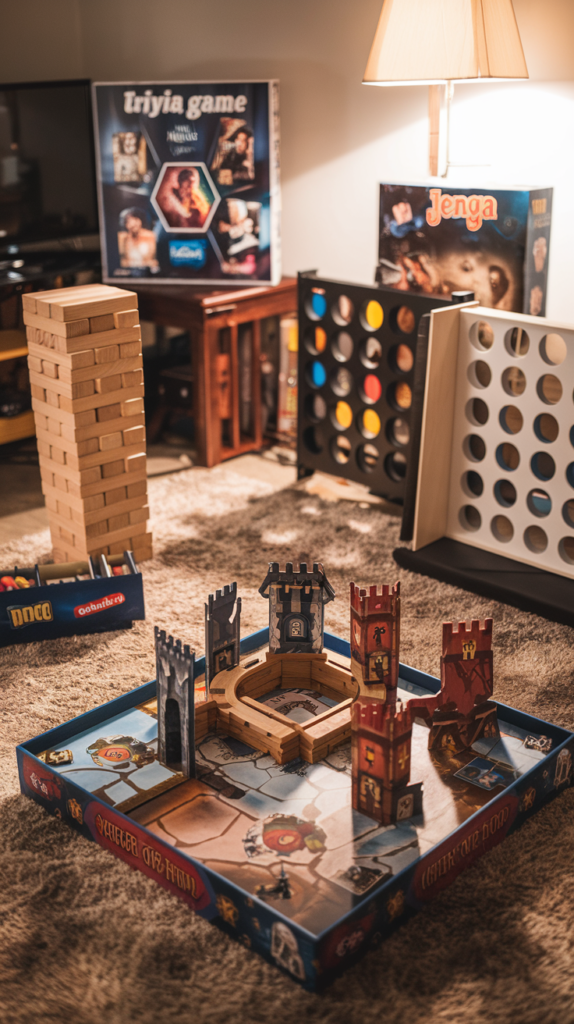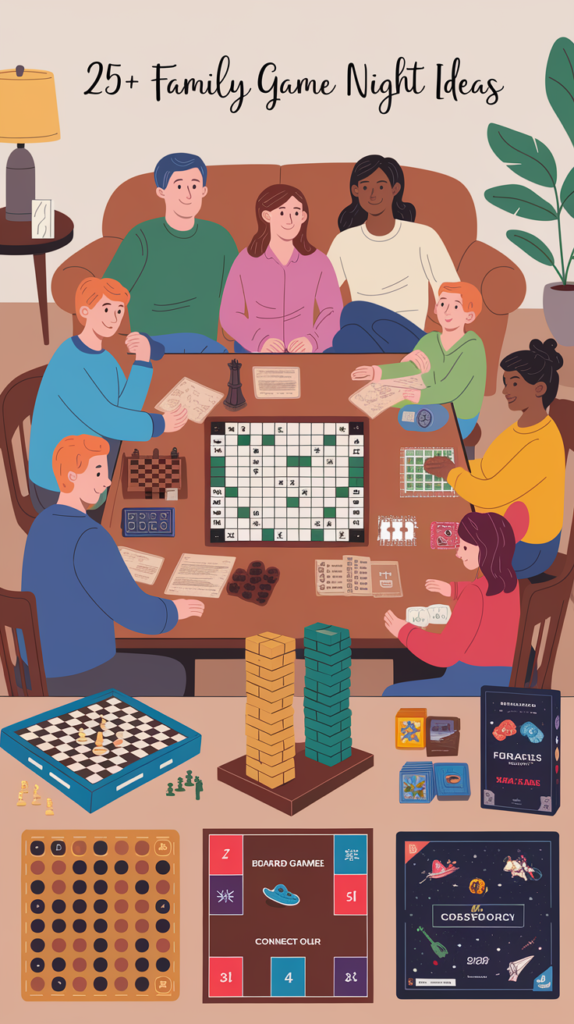Related Post –
Family Game Night Ideas
Here are 10 Family Game Night name ideas:
- Game On!
- Family Fun Frenzy
- Play & Laugh Night
- Together Time Showdown
- Board Game Bonanza
- Card Clash Night
- The Ultimate Game-Off
- Puzzle Party
- Trivia & Treats
- Charades Challenge
Game On!
Game On! is an exciting, all-in-one family game night experience that blends trivia, challenges, and creative tasks into one thrilling competition. Designed to keep every family member engaged, this game offers a variety of mini-games and activities that test knowledge, agility, teamwork, and imagination. Whether you’re solving puzzles, performing physical tasks, or answering fun trivia, Game On! is the ultimate family showdown where laughter and competition go hand in hand.
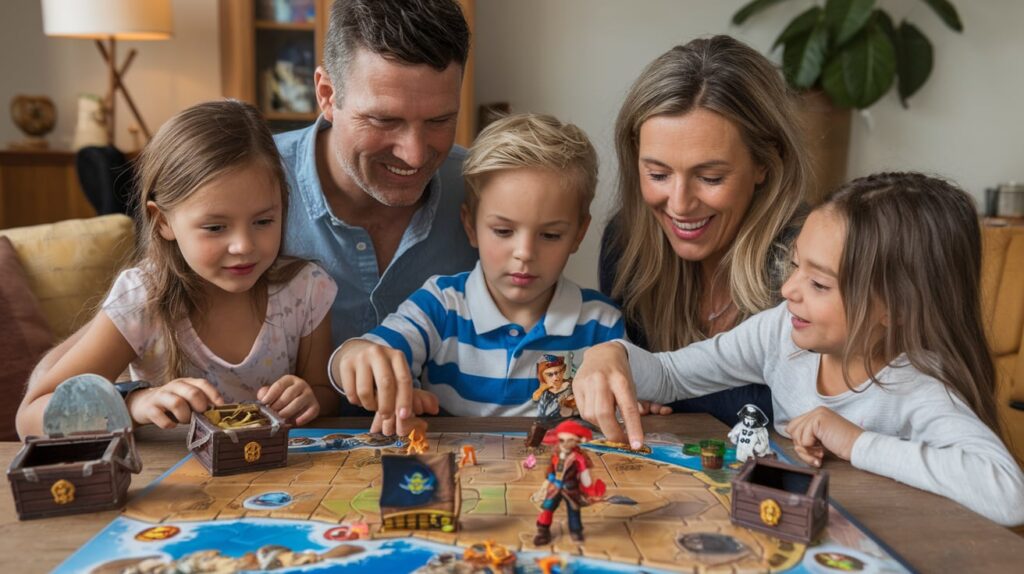
How to Play Game On!: Step-by-Step Guide
Step 1: Game Setup
- Game Board: Set up the Game On! board, which features various categories of challenges including trivia, physical tasks, creative activities, and family-themed questions.
- Player Pieces: Each player selects a game token to represent them on the board. These could be fun objects like miniature figures or household items.
- Cards and Tokens: Prepare the challenge cards, each corresponding to a category such as “Trivia Trials,” “Action Station,” “Creative Corner,” or “Family Facts.” You’ll also need tokens for each team to track points or achievements earned during the game.
Step 2: Choose Teams
- Divide the players into teams, or if the group is small, everyone can play individually. Teams can be made up of two or more players, ensuring a mix of skills and ages for balance and fun.
Step 3: Roll the Dice to Move
- Players take turns rolling a die to move around the game board. The board has different spaces that direct players to complete a task based on the category they land on. For example:
- Trivia Trials: Answer a family-friendly trivia question correctly to advance.
- Action Station: Perform a physical task like balancing a book on your head or hopping on one foot.
- Creative Corner: Engage in a creative activity, like drawing a family member in 30 seconds or creating a rhyme.
- Family Facts: Answer a personal question about someone in the family, like their favorite food or childhood memory.
Step 4: Draw a Challenge Card
- Depending on the space you land on, draw a corresponding challenge card from the deck. Read it out loud, and complete the task. If it’s a trivia or family fact card, other team members or players can ask the question and judge the answer.
Step 5: Completing the Challenge
- If the task is completed successfully (e.g., you answered a trivia question correctly, performed the physical challenge, or created something in Creative Corner), the player or team earns a point or token.
- If a challenge is too difficult, the team can “pass” and move forward on the board, but they lose the chance to earn a point for that round.
Step 6: Special Spaces
- Some spaces on the board are “Power Up” spaces, where players can earn extra tokens or points. These could include:
- Double Points: A correct answer or task here earns double the points.
- Swap Spots: Players can trade places on the board with another player, adding a strategic element.
- Team Play: Teams must work together to complete a bigger challenge, like building a tower with blocks or acting out a scene.
Step 7: End of Turn
- After completing their challenge or task, the player’s turn ends, and play moves to the next player. Turns rotate until all players or teams have had a chance to compete.
Step 8: Winning the Game
- The game continues until a team or player reaches the end of the board or achieves a predetermined point goal. Once the goal is met, the team or player with the most points or tokens is declared the winner and can celebrate their victory!
Game On! is a perfect blend of fun and competition, making family game night unforgettable with its mix of trivia, action, creativity, and family trivia. It’s a game where everyone can shine in their own way, creating memorable moments for the whole family.
Family Fun Frenzy
Family Fun Frenzy is a lively and fast-paced game designed to bring the entire family together for an exciting game night. It blends a variety of mini-challenges, trivia questions, and physical activities into a fun competition where family members race to complete tasks and score points. This game encourages teamwork, quick thinking, and creativity, making it an ideal choice for families of all ages to enjoy together.
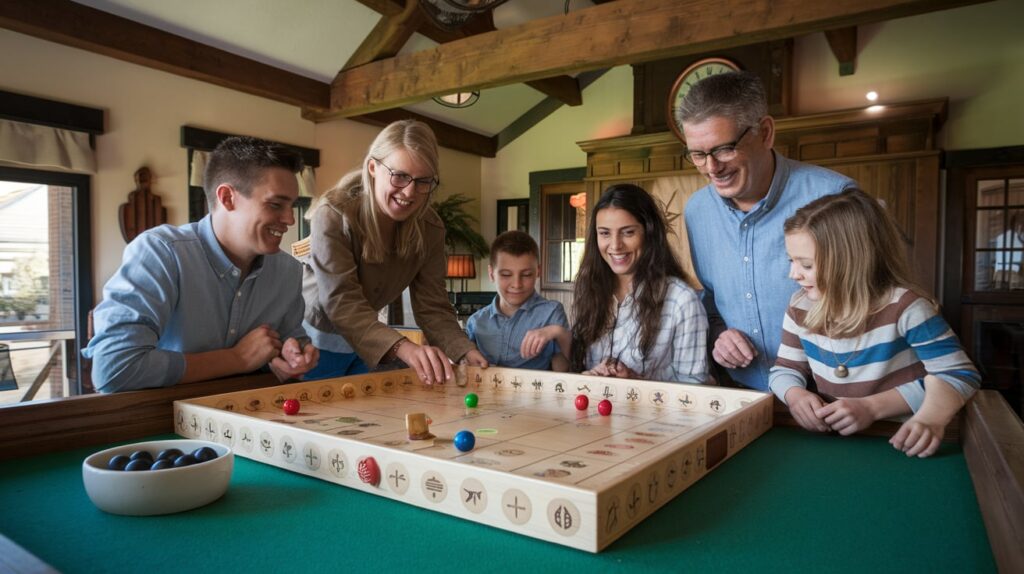
How to Play Family Fun Frenzy: Step-by-Step Guide
Step 1: Game Setup
- Materials Needed: You’ll need index cards, pens, a timer, and tokens or points for scoring. Write down a mix of challenges on the index cards, dividing them into categories such as trivia, physical challenges, or creative activities.
- Teams: Split your family into two or more teams. Try to ensure that teams are balanced in terms of age and ability so everyone can contribute.
- Scoring System: Decide how many points each challenge is worth. For example, trivia questions could be worth 1 point, while physical or creative challenges might earn 2-3 points.
Step 2: Categories of Challenges
- Trivia Challenges: These involve answering general knowledge or family-specific trivia questions. For example, “What’s Dad’s favorite movie?” or “Name a capital city starting with the letter M.”
- Physical Challenges: These include activities like balancing a spoon on your nose, doing a dance, or completing a small obstacle course within a time limit.
- Creative Challenges: These might involve drawing, acting out a scene (like charades), or coming up with rhymes or short songs based on specific words or themes.
Step 3: Turn Order
- Each team takes turns selecting a challenge card from the top of the deck. Teams can decide to either do a trivia challenge, physical challenge, or creative challenge based on their card draw.
Step 4: Completing the Challenge
- Once a challenge card is drawn, a team member has to complete the task while their teammates either guess the answer or cheer them on. Set a timer for each challenge (usually around 30-60 seconds) to keep the game moving quickly and maintain excitement.
- For example, if the card is a trivia question, the team has 30 seconds to answer. If it’s a physical challenge, the player must complete the action within the time limit.
Step 5: Earning Points
- Points are awarded based on successful completion of the challenge. If the team fails to complete the task in time, the other team gets a chance to steal the points by completing the same challenge.
- For example, if Team A couldn’t answer a trivia question, Team B can take a guess and potentially earn the point.
Step 6: Wild Cards
- Add some Wild Cards to the game for unexpected twists. These could involve tasks like “Switch a player with someone from the other team” or “Double or nothing,” where teams can double their points if they complete a particularly tough challenge.
Step 7: Winning the Game
- Play continues for a set number of rounds or until all challenge cards have been drawn. At the end, tally up the points to determine the winning team. The team with the most points wins and could be awarded a small prize or the title of “Family Fun Champions!”
Family Fun Frenzy ensures that every family member, regardless of age or skill, can have a blast. The game combines mental, physical, and creative tasks into an all-in-one experience, turning any family gathering into a memorable, laughter-filled adventure!
Play & Laugh Night
Play & Laugh Night is a lively and entertaining family game designed to bring everyone together for a night filled with fun, laughter, and friendly competition. This game incorporates a mix of classic family favorites and unique challenges, encouraging players to showcase their skills, creativity, and humor. Perfect for family gatherings or game nights, Play & Laugh Night promotes bonding and joyful memories among participants.
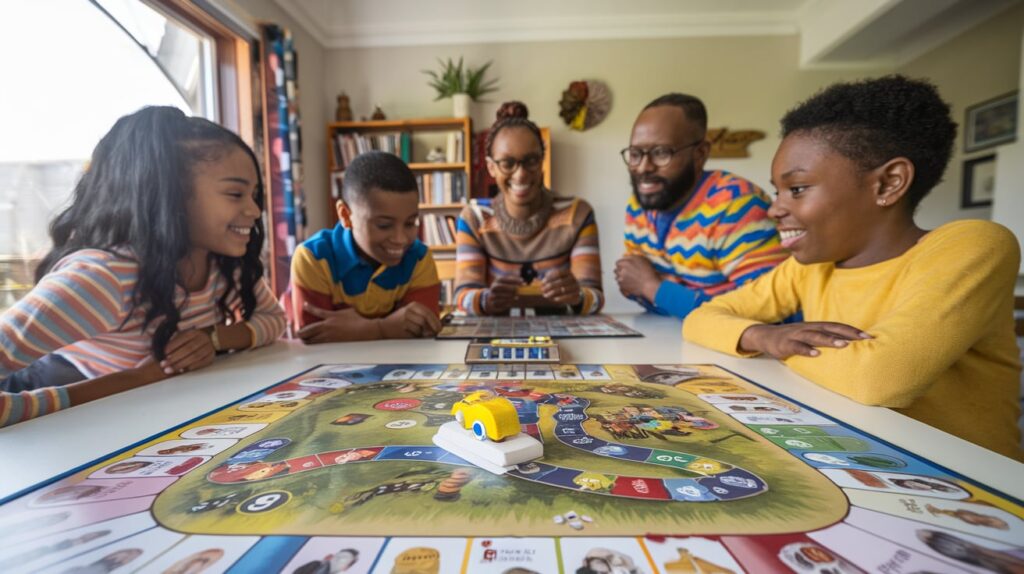
How to Play Play & Laugh Night: Step-by-Step Guide
Step 1: Gather Materials
- Game Components: Prepare a selection of board games, card games, and activity prompts that cater to all ages. This could include games like Pictionary, Charades, or Uno, along with fun challenge cards that require physical activities or creative tasks.
- Timer: Have a timer or stopwatch ready to keep track of each round’s time limit.
- Scorekeeping Supplies: Use a notepad and pen to keep track of each player’s or team’s scores.
Step 2: Set Up Teams
- Divide Participants: Split players into two or more teams, ensuring a balanced mix of ages and abilities within each team. This will promote inclusivity and enhance the fun.
Step 3: Choose Game Rounds
- Game Selection: Decide how many rounds to play and which games or activities will be included. Each round can consist of a different game, a series of prompts, or challenges that players must complete.
- Game Types: Options might include:
- Board Games: Traditional favorites like Monopoly or Scrabble.
- Charades: Acting out phrases or titles without speaking.
- Pictionary: Drawing prompts for teammates to guess.
- Physical Challenges: Activities like balancing a book on the head or completing a mini obstacle course.
Step 4: Determine Turn Order
- Roll for Turns: To decide which team goes first, have each team roll a die. The team with the highest number starts the game.
Step 5: Start the Game
- First Round: The first team begins by selecting a game or challenge for their turn. They can choose from the pre-determined options or draw from a challenge deck, if applicable.
Step 6: Playing the Round
- Engage in the Activity: The active team participates in the chosen game or challenge. For example:
- If they’re playing Pictionary, one member draws while the rest guess the word or phrase.
- If it’s a physical challenge, all team members must complete the task within the allotted time.
- Timer Management: Use the timer to set a time limit for the round (usually around 1-2 minutes). When the time is up, the team’s turn ends.
Step 7: Scoring
- Earn Points: Award points based on the number of correct guesses or successful task completions. For instance, a correct guess in Pictionary might earn the team two points, while completing a physical challenge could earn one point.
Step 8: Rotate Turns
- Alternate Teams: Once the first team completes their turn, the next team takes their turn, following the same process. Continue rotating until all teams have had an opportunity to play.
Step 9: Final Round and Winner Declaration
- Determine Winner: After all rounds are completed, tally up the scores. The team with the highest total score is declared the winner. Celebrate their victory with a fun prize or certificate!
Play & Laugh Night fosters a lively and joyous atmosphere, providing families with an opportunity to strengthen their bonds while creating unforgettable memories through laughter and competition!
Together Time Showdown
Together Time Showdown is an engaging family game designed to strengthen bonds, encourage collaboration, and create unforgettable memories. This game combines elements of trivia, challenges, and cooperative activities, making it a versatile choice for family game night. Players work together in teams, navigating through various rounds that test their knowledge, creativity, and teamwork. The goal is to accumulate points by successfully completing challenges and answering questions, fostering a spirit of friendly competition and collaboration.
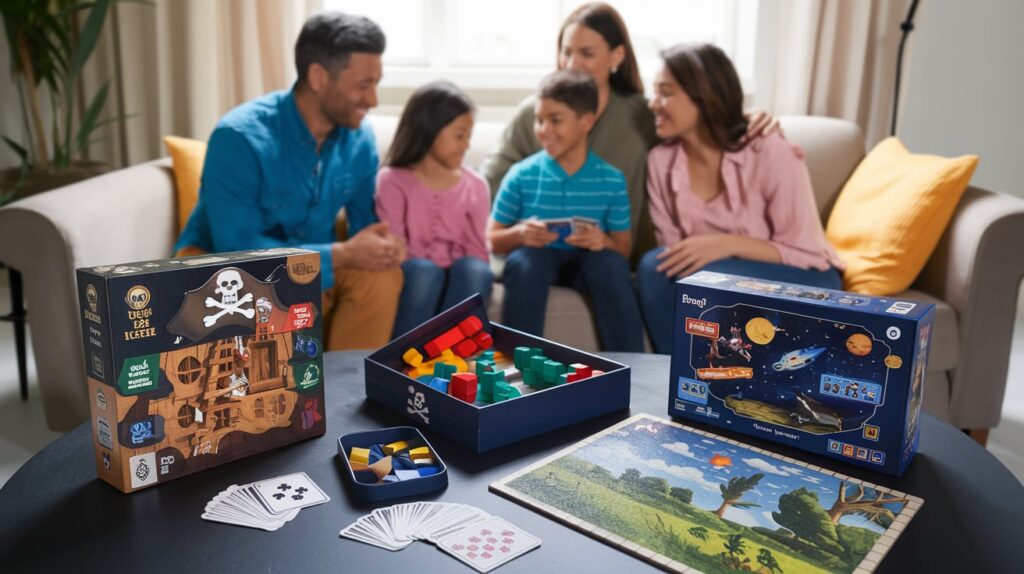
How to Play Together Time Showdown: Step-by-Step Guide
Step 1: Gather Materials
- Game Components: Prepare a variety of materials such as trivia cards, challenge prompts, a timer, a scorekeeping sheet, and player pieces (like game tokens or markers) to represent each team on a game board if applicable.
- Teams: Organize players into two or more teams. Each team should have an equal number of players to ensure fair play.
Step 2: Create Categories
- Question Categories: Develop different categories for trivia questions, such as Family History, Pop Culture, Nature, Sports, or Fun Facts. This diversity allows players of all ages to participate and contribute their knowledge.
- Challenge Types: Prepare a list of challenges that teams must complete, such as charades, drawing contests, or physical activities. This adds variety and excitement to the game.
Step 3: Set Up the Game Board (Optional)
- If using a game board, set it up with designated spaces for trivia questions and challenges. Spaces can be color-coded to indicate which category teams will encounter.
Step 4: Determine the Turn Order
- Decide which team will go first by rolling a die or drawing cards. The team with the highest number starts, and play continues in a clockwise direction.
Step 5: Trivia Questions and Challenges
- On their turn, a team rolls a die (if using a board) or selects a trivia category from a designated set of cards.
- Trivia Round: The opposing team reads a trivia question from the selected category. The active team discusses the answer among themselves, and when they are ready, they provide their response.
- Challenge Round: If a team lands on a challenge space, they must select a challenge prompt and complete the task within a specified time limit (usually 1-2 minutes). This could include acting out a scene, drawing an object, or completing a mini-game.
Step 6: Scoring Points
- Teams earn points for each correct answer given in trivia rounds. For challenges, points are awarded based on successful completion or creativity as determined by the opposing team or a designated judge.
- Keep a running total of points for each team on the scorekeeping sheet.
Step 7: Rotate Turns
- After each team has completed their turn, the next team takes their turn following the same process. Continue rotating through teams until all teams have had several turns or until a set number of rounds is completed.
Step 8: End of the Game
- The game continues until a predetermined score is reached, or after a set number of rounds. The team with the most points at the end is declared the winner and can receive a small prize, like a trophy or a certificate.
Together Time Showdown not only provides a platform for friendly competition but also enhances communication and teamwork within the family, making it an ideal choice for unforgettable game nights!
Board Game Bonanza
Board Game Bonanza is an exciting family game night experience that combines a variety of classic and modern board games into one action-packed event. This game encourages friendly competition and teamwork, allowing players of all ages to engage in different challenges, strategize, and have fun together. It’s perfect for families looking to create lasting memories through shared gameplay while exploring a range of gaming styles and themes.
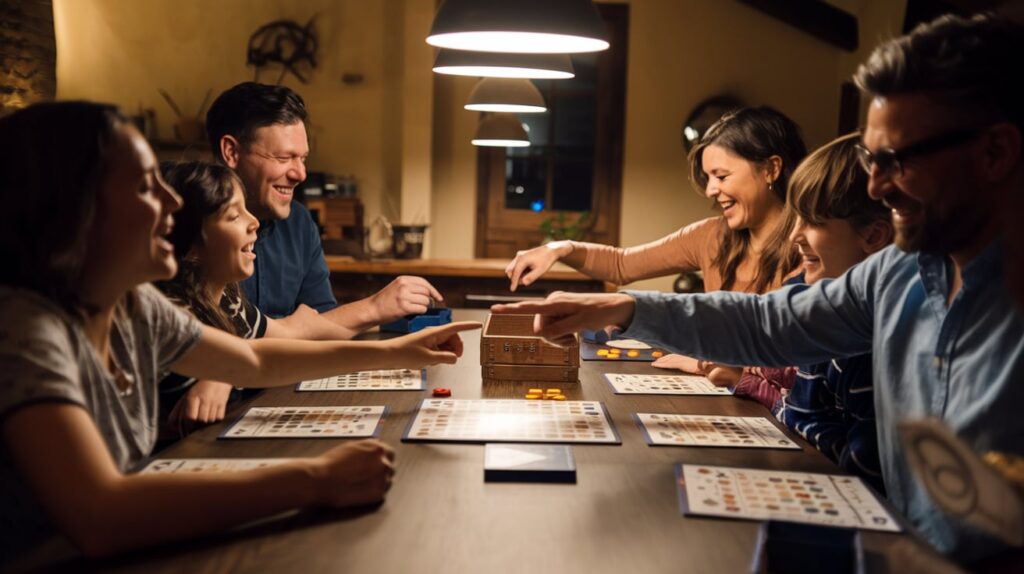
How to Play Board Game Bonanza: Step-by-Step Guide
Step 1: Gather Materials
- Game Selection: Curate a collection of popular board games, such as Monopoly, Scrabble, Clue, Uno, and Jenga. Aim for a mix of strategy, word games, and party games to appeal to all family members.
- Game Board: Create a central game board that outlines the rules and structure of the Bonanza event. Include spaces for each game, points allocation, and bonus challenges.
- Scorekeeping Tools: Prepare a notepad or scoreboard to track each player’s or team’s points throughout the night.
Step 2: Set Up the Game Board
- Layout: Arrange the games around the central board, ensuring each game has enough space for players to gather and play comfortably.
- Game Instructions: Place the rules for each board game nearby, so players can quickly reference them when it’s their turn to play.
Step 3: Form Teams or Play Individually
- Team Formation: Decide whether players will compete in teams or as individuals. Form teams that mix ages and skills to foster inclusivity and encourage collaboration.
- Team Names: Encourage each team to come up with a fun name that reflects their personality or interests.
Step 4: Determine the Order of Play
- Turn Order: Decide the order in which teams or players will take turns. This can be done by rolling dice, drawing cards, or simply going clockwise around the table.
Step 5: Play the Games
- Game Rotation: Each round, a team or player chooses a game to play from the collection. Set a time limit for each game (typically 30-60 minutes) to keep the pace lively.
- Scoring: Players earn points based on the outcomes of each game. For example:
- Monopoly: Points for property ownership or cash.
- Scrabble: Points for words created based on letter values.
- Uno: Points for cards remaining in opponents’ hands.
- Bonus Challenges: Introduce bonus challenges that players can complete during the game, such as trivia questions or mini-games, to earn extra points.
Step 6: Track Points
- As games are played, keep a running total of points earned by each team or player on the scoreboard. Make sure to update it regularly after each game for everyone to see.
Step 7: Rotate Games and Teams
- After the designated time for a game is up, teams can either continue playing the same game or switch to a different game from the collection. Ensure that all players have the opportunity to experience various games throughout the night.
Step 8: Determine the Winner
- After all rounds are completed, tally the points to find out which team or player has accumulated the most points.
- Celebrate the winning team with a fun prize, such as a homemade trophy or a special treat, and acknowledge everyone’s participation for making the night enjoyable.
Board Game Bonanza is a fantastic way for families to bond, laugh, and engage with one another through the power of play, turning a regular game night into an unforgettable adventure filled with excitement and camaraderie!
Card Clash Night
Card Clash Night is an exciting family game that combines strategy, luck, and friendly competition, making it a perfect addition to your family game night. In this engaging card game, players battle against each other by playing various cards with unique abilities and effects. The objective is to outsmart opponents, accumulate points, and ultimately claim victory as the best card strategist in the family.
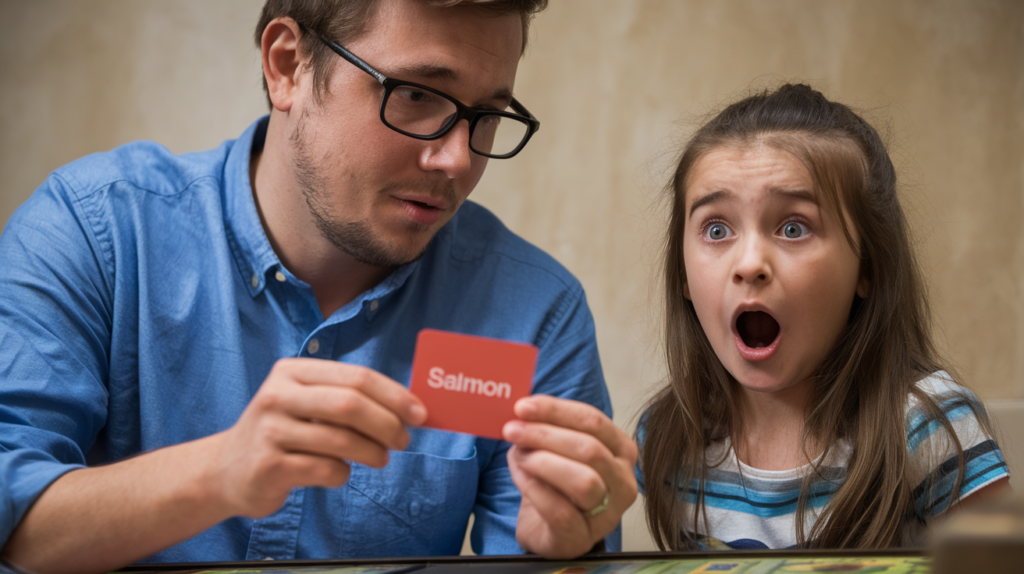
How to Play Card Clash Night: Step-by-Step Guide
Step 1: Game Setup
- Gather Materials: Collect a standard deck of cards or a specialized card game deck if you have one. Ensure you have a flat surface to play on and enough space for all players to comfortably access their cards.
- Determine Players: Card Clash Night can accommodate anywhere from two to six players. Gather everyone around the playing area and ensure each player has enough space to organize their cards.
Step 2: Understanding the Card Types
- Standard Cards: If using a regular deck, players will primarily utilize number cards, face cards, and suits.
- Special Cards: If using a specialized deck, familiarize players with the unique cards, their abilities, and how they interact with one another. These cards may include action cards, power-ups, or defense cards that can change the game’s dynamics.
Step 3: Deal the Cards
- Shuffle the deck thoroughly and deal a predetermined number of cards to each player. A common approach is to deal five to seven cards per player, depending on the total number of players and the length of the game you want to play.
- Place the remaining deck face down in the center of the playing area to form the draw pile.
Step 4: Decide the Turn Order
- Determine the first player through a random method, such as drawing cards or rolling a die. Once the first player is established, play will continue in a clockwise direction.
Step 5: Playing the Game
- On their turn, a player can perform the following actions:
- Play a Card: The player selects a card from their hand and plays it face up on the table, announcing its effect or value.
- Draw a Card: After playing a card, the player draws a card from the draw pile to maintain their hand size.
- Resolving Effects: Depending on the card played, the player must follow through with any specified effects. This could involve attacking another player, stealing a card, or implementing a strategy that affects the game’s flow.
Step 6: Interacting with Opponents
- Players can respond to the card played by the current player if they have cards that can counteract or defend against the action. This could lead to strategic plays, where players must think quickly about their moves and responses.
Step 7: Ending a Round
- A round ends when a player successfully plays all their cards or if the draw pile is exhausted and players can no longer draw. At this point, players tally their points based on the remaining cards in hand (some games assign different point values for different card types).
- Depending on the game’s rules, players can either start a new round or conclude the game after a set number of rounds.
Step 8: Scoring and Winning
- Points can be awarded based on the value of the cards remaining in players’ hands at the end of each round. The player with the highest total points at the end of all rounds is declared the winner of Card Clash Night.
Card Clash Night is not only a thrilling game of wits and strategy but also a fantastic way to enhance family bonds through competition, laughter, and shared experiences!
The Ultimate Game-Off
The Ultimate Game-Off is an action-packed family game night experience that combines a variety of classic games into one thrilling competition. Designed to test players’ skills in trivia, physical challenges, and creative tasks, this game fosters teamwork, laughter, and healthy competition among family members of all ages. The Ultimate Game-Off is perfect for family gatherings, allowing everyone to showcase their talents while enjoying a fun-filled evening together.
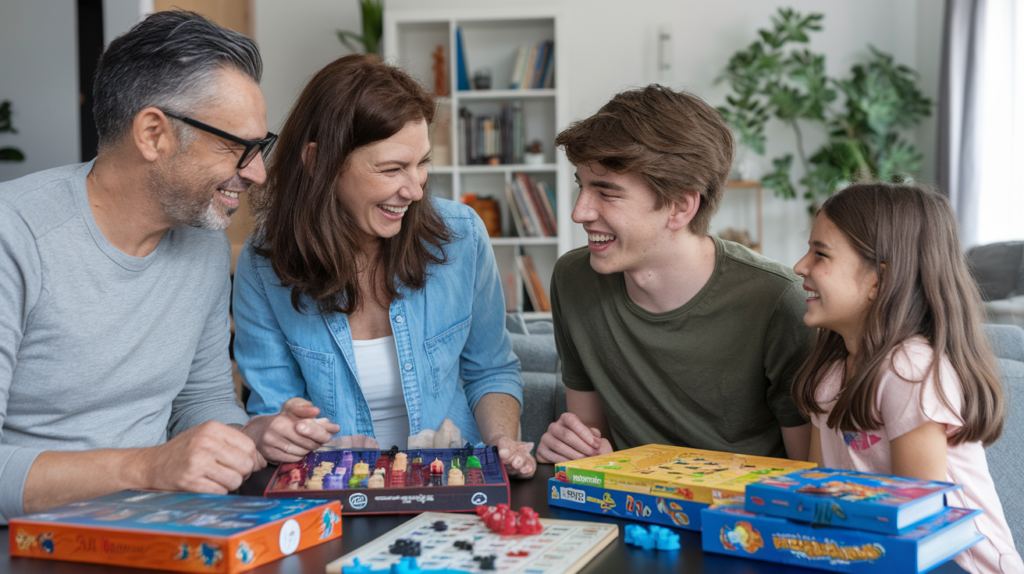
How to Play The Ultimate Game-Off: Step-by-Step Guide
Step 1: Gather Materials
- Game Components: Collect a variety of board games, card games, and activity supplies. Include classic games like charades, Pictionary, trivia cards, and physical challenges such as relay race props (e.g., spoons, balloons, or hula hoops).
- Scoreboard: Prepare a large scoreboard where you can keep track of each family member’s or team’s scores throughout the game.
Step 2: Organize Players
- Team Formation: Divide the players into two or more teams, ensuring each team has a mix of ages and skills. This encourages collaboration and levels the playing field.
- Select a Host: Designate a host or game master responsible for guiding the game, keeping time, and announcing the challenges.
Step 3: Set Up Game Stations
- Station Setup: Arrange different game stations around the playing area, each featuring a specific game or challenge. This can include a trivia corner, a drawing station for Pictionary, and an area for physical challenges.
- Time Limits: Decide on time limits for each station (e.g., 5 minutes) to maintain a fast-paced and exciting atmosphere.
Step 4: Begin the Competition
- Starting the Game: Teams can draw lots or roll dice to determine the order of play. The first team will start at the first station, completing challenges to earn points.
- Rotating Stations: After completing a challenge, teams rotate to the next station in the designated order, ensuring that all teams participate in each challenge.
Step 5: Completing Challenges
- Challenge Types:
- Trivia Questions: Teams answer trivia questions related to a chosen category. Correct answers earn points.
- Charades: Teams act out a word or phrase without speaking while their teammates guess. Points are awarded for correct guesses.
- Pictionary: Teams draw a word or phrase on a whiteboard or paper while their teammates guess. Points are awarded based on correct guesses within the time limit.
- Physical Challenges: Include fun physical tasks, such as balancing a ball on a spoon while walking or completing a mini-obstacle course. Points are awarded based on completion time or creativity.
Step 6: Scoring Points
- Point System: Assign points based on the difficulty of each challenge. For example, trivia questions might be worth 1 point, while completing a physical challenge successfully could earn 3 points. Record the scores on the scoreboard after each round.
Step 7: End of the Game
- Final Round: After all teams have completed every station, consider having a final round with bonus challenges or lightning rounds to give teams a chance to earn additional points.
- Determine the Winner: Tally up the points from each station, and the team with the highest score is crowned the winner of The Ultimate Game-Off. You can present a fun trophy or certificate to the winning team as a token of their victory.
The Ultimate Game-Off is not just a game; it’s a delightful family experience filled with laughter, camaraderie, and unforgettable memories that everyone will cherish long after the game night ends!
Puzzle Party
Puzzle Party is an engaging and collaborative game designed to bring families together during game night while stimulating their minds and encouraging teamwork. In this delightful activity, players work in groups to assemble jigsaw puzzles, competing against the clock and each other to complete their puzzles first. This game combines strategy, communication, and a bit of friendly competition, making it an excellent choice for family gatherings or friendly get-togethers.
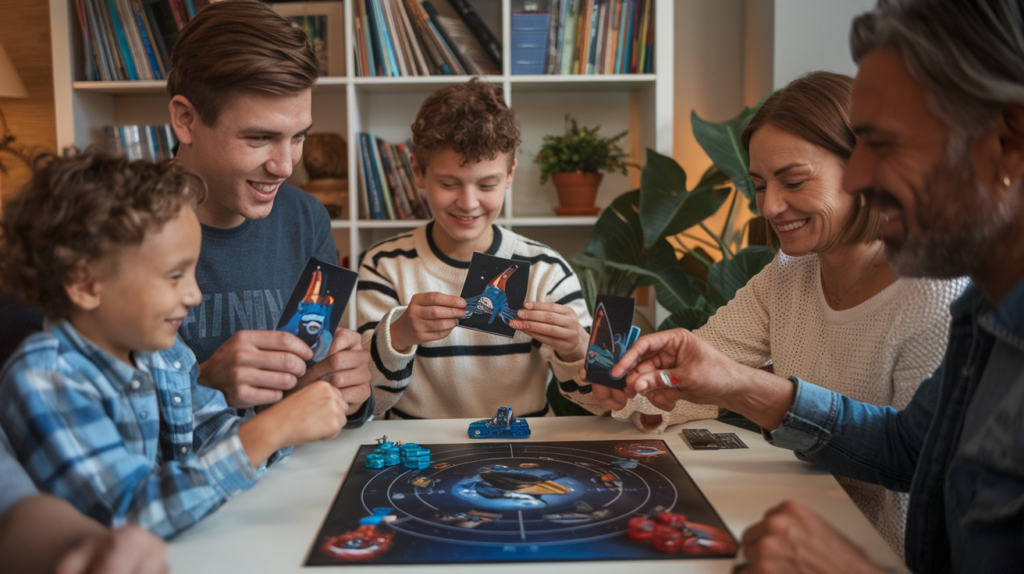
How to Play Puzzle Party: Step-by-Step Guide
Step 1: Gather Materials
- Puzzles: Select a variety of jigsaw puzzles with different themes and difficulty levels. It’s advisable to choose puzzles that have at least 300 pieces to provide a good challenge.
- Tables and Space: Arrange tables or flat surfaces where players can comfortably work on their puzzles. Ensure there’s enough space for everyone to move around freely.
Step 2: Divide into Teams
- Split participants into teams, ideally consisting of two to four players each. This fosters collaboration and makes it easier to assemble the puzzles.
Step 3: Select Puzzles
- Provide each team with a different puzzle. Alternatively, you can use identical puzzles for added competition. If using different puzzles, ensure each has similar piece counts and levels of difficulty to keep the challenge fair.
Step 4: Set the Rules
- Establish clear rules for the game, such as:
- Teams must work together to complete their puzzles.
- Players cannot use any outside tools (like pictures of the completed puzzle).
- Set a time limit (e.g., 30 minutes) for completing the puzzles.
Step 5: Begin the Game
- At the start signal, teams begin working on their puzzles simultaneously. Encourage participants to strategize their approach, discussing how they will sort pieces and tackle different sections of the puzzle.
Step 6: Encourage Teamwork
- As teams work on their puzzles, remind them to communicate effectively. They should share ideas, manage their pieces, and assist each other in finding connecting pieces. This collaborative effort is crucial for success.
Step 7: Track Progress
- Designate someone (possibly a neutral family member) to monitor the time and keep track of progress. If teams are struggling, they can offer subtle hints or encouragement.
Step 8: End of the Game
- When the time is up, stop all teams from working on their puzzles. Each team reveals their completed puzzle or the progress they made. If using identical puzzles, the first team to finish wins. If different puzzles were used, the team that assembled the most pieces correctly in the allotted time can be declared the winner.
Step 9: Celebrate and Reflect
- Acknowledge the efforts of all teams, celebrating the winner with a small prize, such as a fun family trophy or a special treat. Reflect on the teamwork and creativity displayed during the game, reinforcing the importance of collaboration and problem-solving.
Puzzle Party is an entertaining and educational game that not only encourages critical thinking and spatial awareness but also creates lasting memories through laughter and teamwork, making it a perfect addition to any family game night!
Trivia & Treats
Trivia & Treats is an engaging and delicious family game night experience that combines knowledge, strategy, and tasty treats. This game encourages players to answer trivia questions from various categories while earning snacks or treats as rewards. It’s an entertaining way to stimulate minds and satisfy appetites, making it perfect for families looking to bond over fun facts and tasty bites.
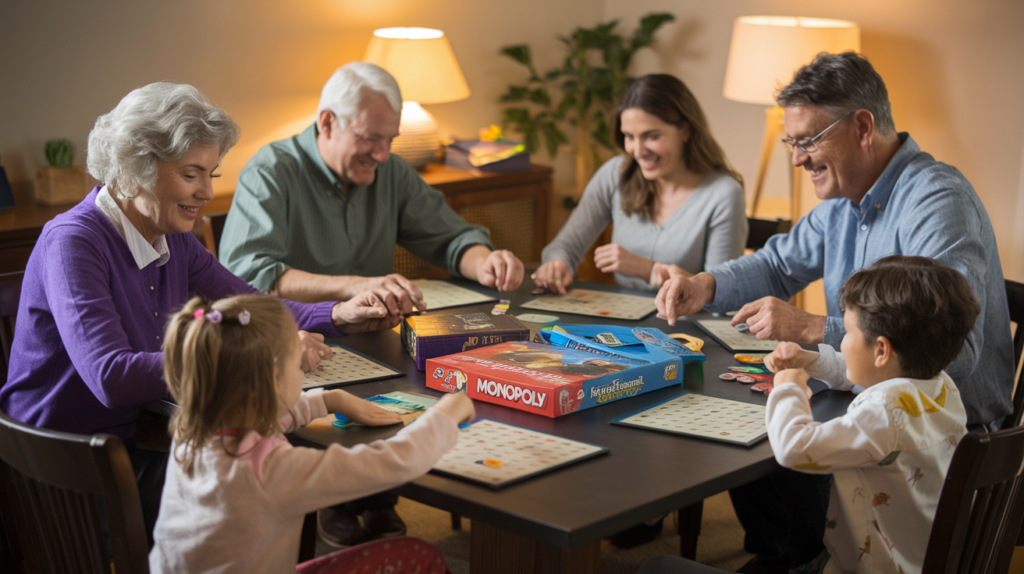
How to Play Trivia & Treats: Step-by-Step Guide
Step 1: Gather Materials
- Trivia Questions: Prepare a list of trivia questions covering diverse categories, such as history, geography, science, pop culture, and sports. Make sure to include a range of difficulty levels to accommodate all ages.
- Treats: Choose a variety of treats or snacks to serve as rewards. These can include candies, cookies, chips, or even healthy options like fruit slices or nuts.
- Game Board or Score Sheet: Create a simple game board or score sheet to track players’ scores and treat rewards.
Step 2: Set Up Teams
- Divide players into teams, ensuring a mix of ages and knowledge levels to encourage collaboration. Depending on the number of participants, you can have two or more teams.
Step 3: Decide the Turn Order
- Determine the order in which teams will play. This can be done by rolling a die, drawing cards, or any other fun method. The first team to go will be the one that starts the game.
Step 4: Question Categories and Scoring
- Decide on categories for the trivia questions and assign point values for each question based on difficulty (e.g., 1 point for easy, 2 points for medium, and 3 points for hard).
- Set a threshold for treats. For instance, for every 5 points a team earns, they get to choose a treat from the snack table.
Step 5: Begin the Trivia Round
- The first team selects a category and answers a trivia question posed by the opposing team or from a prepared list. If the team answers correctly, they earn points based on the question’s difficulty and can choose a treat.
- If they answer incorrectly, the question can be passed to the next team, who can steal the points if they answer correctly.
Step 6: Continue the Rounds
- Rotate through each team, allowing them to choose categories and answer questions in turn. Keep the game dynamic by introducing a timer (e.g., 30 seconds) for each question, encouraging quick thinking.
Step 7: Enjoying Treats
- As teams accumulate points, they can redeem their scores for treats. This adds an exciting element, as players look forward to enjoying snacks after answering questions correctly.
Step 8: End of the Game
- The game continues until all trivia questions are answered or until a predetermined number of rounds are completed.After the final round, tally each team’s total points to determine the winner.
- The winning team can receive a special prize, such as a larger treat or a fun game-related trophy, while all players can enjoy the snacks they earned.
Trivia & Treats is a delightful way to stimulate minds and taste buds, making it a fantastic choice for Family Game Night Ideas filled with laughter, learning, and delectable rewards!
Charades Challenge
Charades Challenge is a lively and entertaining game perfect for family game nights, where players use their creativity and acting skills to convey words or phrases without speaking. This classic game fosters teamwork and laughter, making it an enjoyable experience for participants of all ages. It encourages players to think quickly and express themselves through gestures and body language, creating memorable moments for families to cherish.
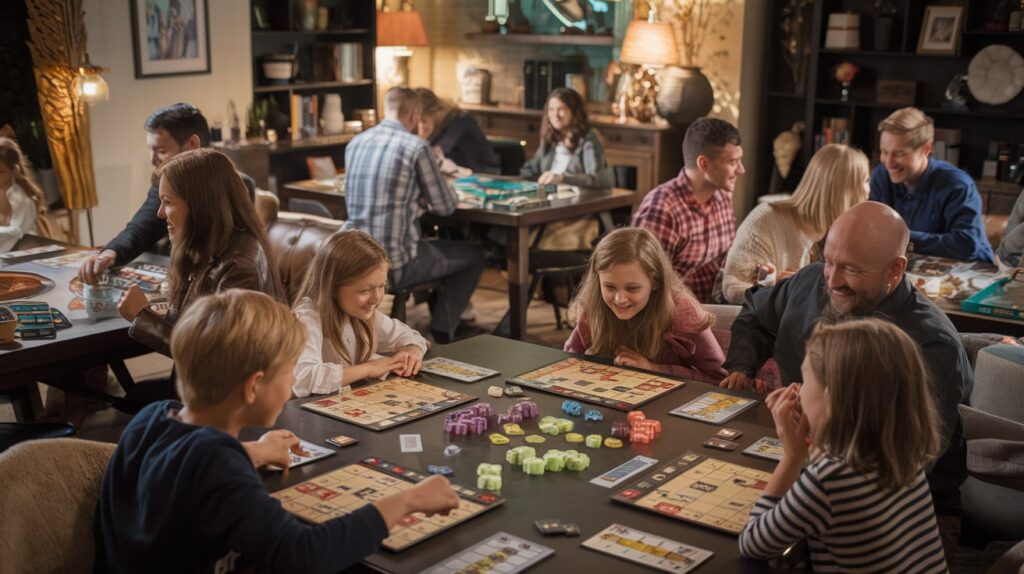
How to Play Charades Challenge: Step-by-Step Guide
Step 1: Gather Materials
- Materials Needed: You will need a set of prompt cards containing various words or phrases to act out. These can be written on slips of paper or index cards. You can also use a timer or a stopwatch to keep track of the time for each turn.
- Group Formation: Divide participants into two or more teams, ensuring each team has an equal number of players to maintain fairness.
Step 2: Prepare the Prompt Cards
- Create a diverse list of prompts that can include categories such as movies, books, animals, actions, or famous phrases. Aim for a mix of easy and challenging prompts to accommodate players of different skill levels. Place the cards in a container or a bowl for easy access during the game.
Step 3: Determine the Turn Order
- Decide which team will go first by rolling a die or drawing cards. The team with the highest roll or card value gets the first turn.
Step 4: Acting Out the Prompts
- On their turn, a player from the active team draws a prompt card from the container without revealing it to their teammates. They will have a set time limit (usually 60 seconds) to act out the prompt using only gestures, facial expressions, and body movements.
- No Talking or Sounds: The acting player cannot speak, make sounds, or use props. They must rely solely on their physical expressions to convey the word or phrase.
Step 5: Team Guessing
- While the player acts out the prompt, their teammates shout out guesses. The goal is to guess the correct prompt before the time runs out. If they successfully guess the word or phrase, the team earns a point.
Step 6: Rotate Turns
- After the turn is completed, regardless of whether the prompt was guessed correctly or not, the next team takes their turn. Rotate the turns until all players have had a chance to act or until a predetermined number of rounds are completed.
Step 7: Scoring Points
- Keep track of each team’s points throughout the game. Teams score points for each correctly guessed prompt. You can keep a tally on a notepad or whiteboard for easy reference.
Step 8: End of the Game
- The game can be played for a specific number of rounds or until one team reaches a certain point threshold. At the end of the game, the team with the highest score is declared the winner and can be rewarded with a small prize or a fun family title.
The Charades Challenge game not only provides hours of entertainment but also fosters creativity, communication, and bonding among family members, making it an ideal choice for any Family Game Night Ideas!

Hi, I’m Maggie Culp, the founder of PartyVibesFun.com, based in North Little Rock, Arkansas, United States! With a passion for creating unforgettable celebrations, I specialize in turning any event into a fun and vibrant experience. From birthday parties to themed gatherings, I’m here to help you bring your party ideas to life with ease and excitement. Whether you’re looking for unique games, creative themes, or party planning tips, I’m dedicated to making sure every moment of your event is filled with joy. Let’s create memories together and make your next party the talk of the town!

